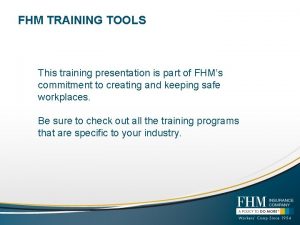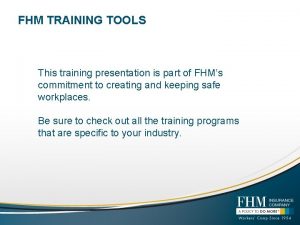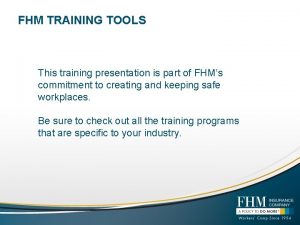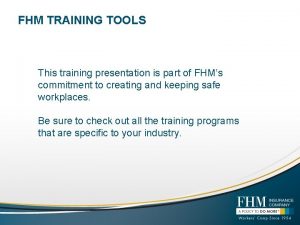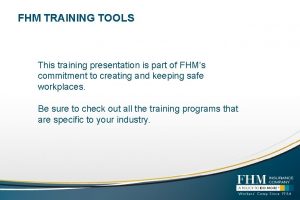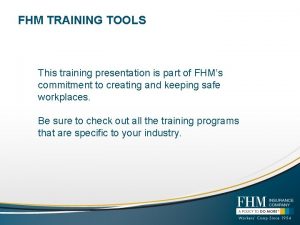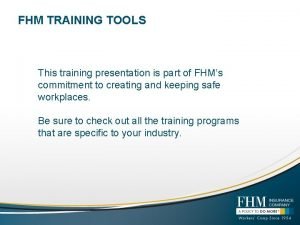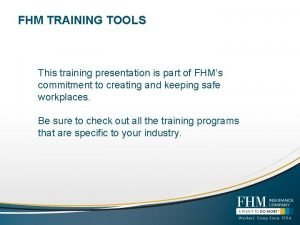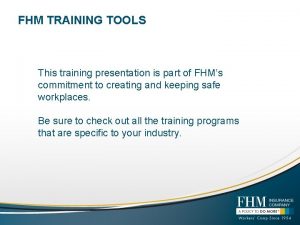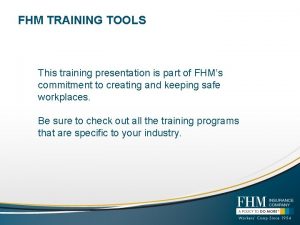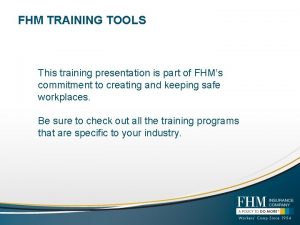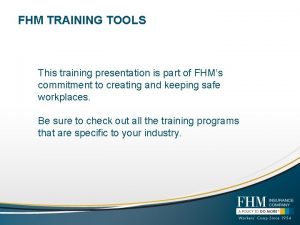FHM TRAINING TOOLS This training presentation is part






















- Slides: 22

FHM TRAINING TOOLS This training presentation is part of FHM’s commitment to creating and keeping safe workplaces. Be sure to check out all the training programs that are specific to your industry. Your Job Your Life: Staying Safe with the Agitated or Violent Patient 1

Protecting Our Caregivers from Combative Patients As a Healthcare Professional You Have the Right to Remain Safe!

Emergency Department Professionals Exposed to Violence Daily Violence in emergency departments has reached epidemic proportions. The Emergency Nurses Association’s position on violence in the Emergency Care Setting states, “Healthcare organizations have a responsibility to provide a safe and secure environment for their employees and the public. ” The Joint Commission on Accreditation of Healthcare Organizations standards require healthcare organizations to have measures in place to ensure the safety of both employees and patients. Your Job Your Life: Staying Safe with the Agitated or Violent Patient 3

Legal Responsibility Duty to protect - Litigation for 1) Failure to restrain or detain violent patients. 2) Failure to protect patients, visitors, or staff. Duty to use the least restrictive techniques necessary Litigation for 1) Detention / seclusion / restraint or injury during restraint process. 2) Assault and battery. 3) False imprisonment. A suit for assault and battery and false imprisonment is easier to defend and less likely to be successful than a suit for wrongful death. The legal liability, for both harm and legal damages, is likely to be lower if health care professionals err on the side of preventing violence. Medical personnel may be held responsible for failing to notify authorities if they know a violent patient has made clear threats to harm a specific person. Your Job Your Life: Staying Safe with the Agitated or Violent Patient 4

A Recent Survey of Emergency Department Nurses Shows that… • 97% reported verbal abuse. • 94% had received physical threats. • 66% Were physically assaulted. • 25% of all nurse assaults occurred in the Emergency Department. • Of the 51 Nurse homicides reported, 23% occurred in Emergency Departments. Your Job Your Life: Staying Safe with the Agitated or Violent Patient 5

Incidents are Underreported Incidents A recent Emergency Nurses Association study revealed that 82% of nurses surveyed have been assaulted sometime during their career, yet a significant number of assaults were not reported. Reason for Underreporting § Afraid of upsetting family members § Lack of time and training § Concern for personal safety § Incidents in which a patient or visitor brings a weapon into the ED are also underreported. Your Job Your Life: Staying Safe with the Agitated or Violent Patient 6

EMERGENCY DEPARTMENT VIOLENCE OVERVIEW Incidence of Violence § Violence in waiting rooms and treatment areas is becoming increasingly common and dangerous. § 70% of emergency nurses are assaulted on duty during their career. § The majority of all violence takes place during the evening and night shifts. § At lease 4% to 5% of patients, families, or visitors carry a lethal weapon into the ED. § Workplace violence is the leading cause of occupational death for women and a third of the leading cause of death for all workers. Your Job Your Life: Staying Safe with the Agitated or Violent Patient 7

EMERGENCY DEPARTMENT VIOLENCE OVERVIEW Why increased risk of violence in the ED § Easy, open access § High stress environment § Diverse range of clientele § Increased violence in society § Minimal to non-existent security § Lack of support from administration § Prolonged waiting times & overcrowding § Lack of physical protection § Lack of appropriate security protocols, policies, and procedures § ED used for medical clearance of alcohol and drug arrest Your Job Your Life: Staying Safe with the Agitated or Violent Patient 8

EMERGENCY DEPARTMENT VIOLENCE OVERVIEW Patient risk factors for violence § § § § Substance abuse (drugs or alcohol) Violence (gang or domestic related) Behavior health issues (psy. pt. not taking medication) Psychiatric illness (manic, paranoid, schizophrenic pts) Verbal abuse (profanity, communicating a threat) History of prior violence (good predictor) Violence victim / violence perpetrator (men / women) Aggressive behavior Your Job Your Life: Staying Safe with the Agitated or Violent Patient 9

EMERGENCY DEPARTMENT VIOLENCE OVERVIEW Violence Prevention Strategies Worksite Analysis § Hazard Prevention and Control Plan § Recordkeeping and evaluation § These elements are designed to help recognize, identify, and correct security threats Education and Training § § § § § Train on the management of assaultive behavior How to recognize a threat Incident reporting Potential risk of illness and injuries from assault Incident prevention Progressive behavior control methods Restraint application How to avoid high risk situations and Learn defusing techniques Your Job Your Life: Staying Safe with the Agitated or Violent Patient 10

Violence Prevention Strategies Patient Interaction: § Consider allowing a family member to stay with the patient § Limit visitation in the treatment location Personal Measures: § § Obtain training / education on ED violence Remove personal items that could be used as a weapon Do not divulge any personal information Call security as soon as danger is suspected Your Job Your Life: Staying Safe with the Agitated or Violent Patient 11

Violence Prevention Strategies (continued) Interview Setting and Techniques § Always give your self access to the door § Store or remove supplies/equip that could be used as a potential weapon § Use an Exam Room close to fellow workers Patient Interviewing Techniques § Be honest, straightforward, and frank but not overly friendly § Assure patient safety § Assure patient comfort § Present clear limits / options for patient § Explain to the patient they will not be able to harm themselves or others § Use non-confrontational posture such as arms uncrossed and hands in view § Avoid excessive eye contact § Never lock or block door § Avoid entering the patient’s personal space § Never, ever touch a violent patient before asking them § Never approach a patient from behind § Have security inside the examination room or just outside an open door when dealing with potentially violent patient § Never attempt to examine an armed patient. Have security or, if available, a police officer unarm an armed patient. Tell them their firearm can be retrieved at discharge Your Job Your Life: Staying Safe with the Agitated or Violent Patient 12

Violence Prevention Strategies (continued) Department Policies § § § § Recording of violent incidents Verbal attacks or aggressive behavior incidents Recognizing high risk behavior Managing hostile or verbally threatening people Visitor control Staffing Post incident response ED worksite analysis Hazard Prevention and Control Restraint application Training Hazard Prevention and Control Plan Panic alarm system Your Job Your Life: Staying Safe with the Agitated or Violent Patient 13

Security Policy § The Emergency Department is an area of the hospital that is particularly vulnerable to violence. To counter this hospitals must have comprehensive protocols, policies, and procedures. § It is the responsibility of the Security Department to establish and maintain reasonable security measures for the Emergency Department by providing specific guidelines for the implementation and maintenance of a safe environment to provide the best possible atmosphere for patients, employees, and staff Your Job Your Life: Staying Safe with the Agitated or Violent Patient 14

POLICY ELEMENTS STAFFING Appropriate Security Staffing will be posted PATROL DUTIES § § § § Triage Areas Acute Treatment Areas Non-Acute Treatment Areas Patient Registration Patient Waiting Rooms Pediatric Screening Clinics and Waiting Areas ED Ambulance Entrance Your Job Your Life: Staying Safe with the Agitated or Violent Patient 15

SECURITY POLICY ELEMENTS SECURITY DUTIES § Security officers should be stationed at a strategic location. § Assist staff in restricting visitation § Intervene when there is an escalation to threats, violence, refusal to comply with staff instructions Your Job Your Life: Staying Safe with the Agitated or Violent Patient 16

SECURITY POLICY ELEMENTS (continued) § § § Risk assessment of patients w/increased potential Victims of violence (gunshot wounds, other weapons) Patients in custody Patients suspected of possessing weapons Psychiatric patients (including overdose patients) Injuries to visitors (make an incident report) Intoxicated patients (drugs or alcohol) Patients involved in violence (gang or domestic) Victims of violence (assault, abuse, neglect) Violent / disruptive patient or visitor Large groups of visitors (gangs, families) Your Job Your Life: Staying Safe with the Agitated or Violent Patient 17

SECURITY POLICY ELEMENTS (continued) § Assist with restraint and control of patients upon request § Assist in restraint management decision § Maintain liaison with ED staff and behavior health staff § Access control § Metal detection § Emergency alert systems § Closed circuit television surveillance § Patient risk assessment Your Job Your Life: Staying Safe with the Agitated or Violent Patient 18

An Effective Violence Prevention Program Should Contain the Following Elements Worksite Analysis A Hazard Prevention & Control Plan and training employees and staff in: § How to recognize potential threats § Incident reporting process § Recording of violent incident § Recognizing high risk behavior § Managing hostile or verbally threatening patient § Reporting assaultive behavior § Availability of assistance Record Keeping Should Contain: § Recording violent incidents § Safety committee minutes reflect these violent incidents § OSHA Form 300 Log Your Job Your Life: Staying Safe with the Agitated or Violent Patient 19

SUMMARY The Joint Commission’s “Management of the Environment of Care” states hospital’s goal should be to provide a safe, effective and functional environment for patients, staff, and visitors, which includes using processes and activities to reduce risk, prevent injuries, and maintain a safe condition for all patients, visitors, and employees. The Joint Commission also states that limiting access and visitor control is an important approach to reducing risk. Your Job Your Life: Staying Safe with the Agitated or Violent Patient 20

SUMMARY Communications Verbal and non-verbal communication are essential tools for employees to use in reducing violence. 90% of human interface is non-verbal communication. Structured education and training should be conducted for ED Staff, as well as physicians, that addresses how to recognize, avoid, or diffuse potentially violent situations. The training should cover verbal and non-verbal communications as well. ED employees, staff and physicians should be trained on nonviolent Crisis Intervention (CPI) Training. Your Job Your Life: Staying Safe with the Agitated or Violent Patient 21

SUMMARY Expect Continued Growth in Combative Patients Violence in the Emergency Department setting continues to increase across the country. Emergency Department safety should be of paramount importance to you and your hospital. A comprehensive security assessment plan can help identify the relative strengths and weaknesses in your program, and identify proactive measures to provide the highest possible level of security for you and your fellow healthcare professionals. New security technology should also be an integral component of any program, along with sound protocols, policies, and procedures. Your Job Your Life: Staying Safe with the Agitated or Violent Patient 22
 Fhm security
Fhm security Eduhk fhm
Eduhk fhm Fhm auswahlverfahren erfahrung
Fhm auswahlverfahren erfahrung Fhm england
Fhm england Fhm parts
Fhm parts Cutting tools in sewing with pictures and meaning
Cutting tools in sewing with pictures and meaning Part whole model subtraction
Part whole model subtraction Unit ratio definition
Unit ratio definition Part part whole
Part part whole Technical description
Technical description It is the vertical part of the front bar.
It is the vertical part of the front bar. The phase of the moon you see depends on ______.
The phase of the moon you see depends on ______. Minitab adalah
Minitab adalah 8-4 project part two: presentation
8-4 project part two: presentation Diameters of fetal head
Diameters of fetal head Vertex presentation and cephalic presentation
Vertex presentation and cephalic presentation Power tools safety training ppt
Power tools safety training ppt Drc alabama online tools training
Drc alabama online tools training New miner training record/certificate
New miner training record/certificate Part 135 recurrent training
Part 135 recurrent training Medicare part d training for pharmacies
Medicare part d training for pharmacies Social media training presentation
Social media training presentation Oral presentation skills ppt
Oral presentation skills ppt




